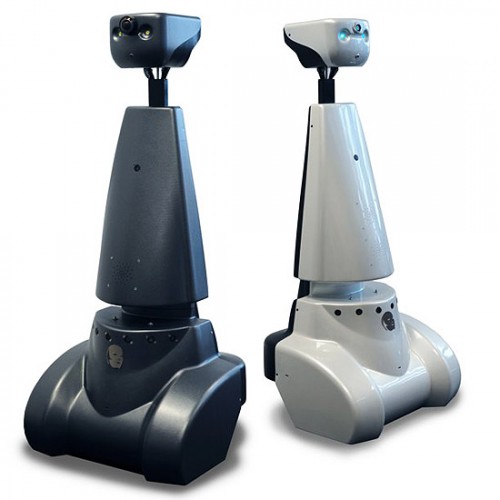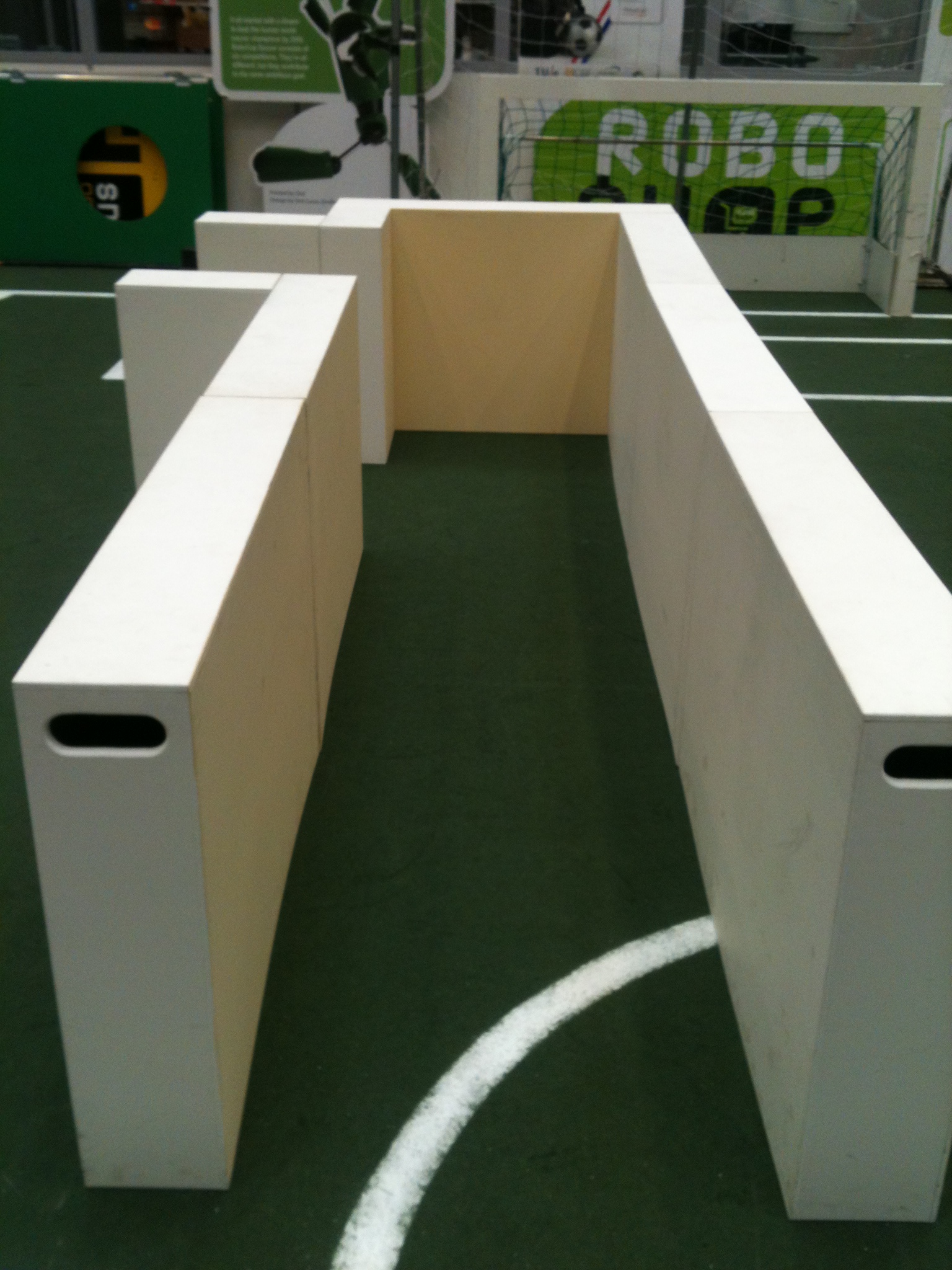Embedded Motion Control 2013
Guide towards the assignment
'A-MAZE-ING PICO'

Introduction
This course is about software design and how to apply this in the context of autonomous robots. The accompanying assignment is about applying this knowledge to a real-life robotics task in which ROS will be the standard software framework.
Course Schedule and Lecture Slides
Lectures will be given on Wednesdays from 10.45 - 12.30 in Gemini-Zuid 3A08. The course schedule is as follows:
| September, 4th | Introduction | Assignment and basic computer setup |
| September, 11th | Localization | C++ and ROS Concepts |
| September, 18th | Navigation (slides,survey) | Software design |
| September 25th | Corridor competition | |
| October, 2nd | The “5Cs” and other meta-models for Embedded Control Systems (Herman Bruyninckx) | |
| October 9th | Image processing using OpenCV | AMIGO's software architecture: performing a RoboCup Challenge |
| October 16th | Intelligent agents | |
| October 23th | Final competition | |
Pico test schedule
In order to test your software on the Pico robot, each group has one one hour time slot a week available. You can reserve your test slot in the table below. There is a one hour break in between the slots, since Pico and its laptop need some time to recharge.
| Date | Time | Group |
|---|---|---|
| 18-09-2013 | 16.00-17.00 | Group 11 (battery not charged) |
| 19-09-2013 | 9.00-10.00 | Group 8 |
| 19-09-2013 | 13.00-14.00 | Group 3 |
| 19-09-2013 | 16.00-17.00 | Group 7 |
| 20-09-2013 | 9.00-10.00 | |
| 20-09-2013 | 11.00-12.00 | |
| 20-09-2013 | 13.00-14.00 | Group 2 |
| 20-09-2013 | 15.00-16.00 | Group 9 (pico down) |
| Date | Time | Group |
|---|---|---|
| 23-09-2013 | 10:00-11:00 | Group 5 |
| 23-09-2013 | 12:00-13:00 | Group 3 (network down) |
| 23-09-2013 | 14:00-15:00 | Group 9 (Pico down) |
| 23-09-2013 | 16.00-17.00 | Group 11 (Pico down) |
| 24-09-2013 | 11.00-12.00 | Group 10 |
| 24-09-2013 | 13.00-14.00 | Group 3 |
| 24-09-2013 | 15.00-16.00 | Group 9 |
| 24-09-2013 | 17.00-18.00 | Group 11 |
| 26-09-2013 | 9.00-10.00 | |
| 26-09-2013 | 11.00-12.00 | Group 2 (Pico down) |
| 26-09-2013 | 13.00-14.00 | |
| 26-09-2013 | 15.00-16.00 | |
| 27-09-2013 | 9.00-10.00 | Group 2 (Problems with Laser) |
| 27-09-2013 | 11.00-12.00 | |
| 27-09-2013 | 13.00-14.00 | |
| 27-09-2013 | 15.00-16.00 | Group 8 |
| Date | Time | Group |
|---|---|---|
| 03-10-2013 | 9.00-10.00 | Group 3 |
| 03-10-2013 | 11.00-12.00 | Group 2 |
| 03-10-2013 | 13.00-14.00 | Group 5 |
| 03-10-2013 | 15.00-16.00 | Group 11 |
| 04-10-2013 | 9.00-10.00 | |
| 04-10-2013 | 11.00-12.00 | Group 9 |
| 04-10-2013 | 13.00-14.00 | Group 7 |
| 04-10-2013 | 15.00-16.00 | Group 8 |
| Date | Time | Group |
|---|---|---|
| 11-10-2013 | 9.00-10.00 | Group 2 |
| 11-10-2013 | 10.00-11.00 | Group 5 |
| 11-10-2013 | 11.00-12.00 | Group 11 |
| 11-10-2013 | 12.00-13.00 | Group 7 |
| 11-10-2013 | 13.00-14.00 | Group 9 |
| 11-10-2013 | 14.00-15.00 | Group 3 |
| 11-10-2013 | 15.00-16.00 | Group 8 |
| 11-10-2013 | 16.00-17.00 | Group 1 |
| Date | Time | Group |
|---|---|---|
| 16-10-2013 | 11.00-12.30 | Group 11 |
| 16-10-2013 | 13.00-14.30 | |
| 16-10-2013 | 15.00-16.30 | |
| 17-10-2013 | 9.00-10.30 | |
| 17-10-2013 | 11.00-12.30 | Group 3 |
| 17-10-2013 | 13.00-14.30 | |
| 17-10-2013 | 15.00-16.30 | Group 7 |
| 18-10-2013 | 9.00-10.30 | Group 2 |
| 18-10-2013 | 11.00-12.30 | Group 5 |
| 18-10-2013 | 13.00-14.30 | Group 9 |
| 18-10-2013 | 15.00-16.30 | Group 8 |
| Date | Time | Group |
|---|---|---|
| 21-10-2013 | 9.00-10.00 | |
| 21-10-2013 | 10.30-11.30 | |
| 21-10-2013 | 12.00-13.00 | |
| 21-10-2013 | 13.30-14.30 | Group 2 |
| 21-10-2013 | 15.00-16.00 | |
| 22-10-2013 | 9.00-10.00 | |
| 22-10-2013 | 10.30-11.30 | |
| 22-10-2013 | 12.00-13.00 | |
| 22-10-2013 | 13.30-14.30 | Group 3 |
| 22-10-2013 | 15.00-16.00 | Group 11 |
Goal
The goal of the assignment is to get the real-time concepts in embedded software design operational.
The concrete task that has to be solved is to let the PICO robot find his way out of a maze. The final demonstration by each participating group of 4-5 students will be performed during a contest, the winner of which is the group that exits the maze in the shortest amount of time. To prepare for this competition the following guidelines have to be considered:
- to test with PICO and to prepare for the final contest, a simulator will be made available that mimics the in and outputs to the real robot. Specifics of this simulator will be presented in the first lecture on September 4th
- the maze of the final competition will be constructed just before the competition. The maze presented in the simulator is therefore different from the real one used in the final contest.
- both on the real and simulated PICO robot, three sources of sensor information will be available to perceive the environment and to derive the state of the robot:
- laserdata provided by the forward pointing laser scanner,
- images captured by the monocular camera,
- odometry provided by the base controller
- the robot can be actuated by sending information to the base controller
- during the final contest, it is highly imperative that the PICO robot refrains from colliding with the walls in the maze. Colliding with the walls will result in severe time-penalties.
- the walls of the maze will contain several types of pointers to the exit, which can potentially help PICO to speed up execution of the task Click here for a pdf file containing the arrow we will use. We also captured PICO's camera topics in a bag file while the robot was looking at the arrow. You can play this bag file as follows:
rosbag play 2013-10-08-15-35-04.bag
The topics /pico/camera and /pico/camera_info should then become available. For example, while playing the bag file, userosrun image_view image_view image:=/pico/camera
to view the camera images.
Corridor Competition
An intermediate review will be held on May 16th, during the corridor competition. During this challenge the students have to let the robot drive through a corridor and then take the first exit. The precise location of this exit will not be given in advance. Some facts:
During the final contest, the groups are expected to give a short (5 minute) presentation about their progress and design decisions. During the corridor competition no presentation is expected.
Hardware
The mobile PICO robot with monocular camera and laser range finder with a working ROS interface. In addition, we provide a Jazz simulator for offline testing.
Getting Started
To get started, please do the following tutorials:
- This manual describes how to the install the necessary and sufficient software to start programming the PICO robot.
- C++ tutorials:
- ROS tutorial
- Note that you have already installed and configured your ROS environment, so you can skip the first tutorial.
- Skip tutorials about Catkin and choose the rosbuild version of a tutorial when possible
- It is advised to work in your group folder, i.e., ~/ros/emc/emc?.
- Getting started with the Jazz simulator
- Using Pico
FAQ
Here you can find a collection of Frequently Asked Questions. Please check this page before contacting Yanick or the tutors! If you find any issues or questions you had to deal with, please add them as well so your colleagues don't run into the same problems.
Group Wiki Pages
Group 01 - Visit Wiki - Tutor: Jos Elfring -
Group 02 - Visit Wiki - Tutor: Rob Janssen -
Group 03 - Visit Wiki - Tutor: Janno Lunenburg -
Group 04 - Visit Wiki - Tutor: - -
Group 05 - Visit Wiki - Tutor: Sjoerd van den Dries -
Group 06 - Visit Wiki - Tutor: - -
Group 07 - Visit Wiki - Tutor: Jos Elfring -
Group 08 - Visit Wiki - Tutor: Rob Janssen -
Group 09 - Visit Wiki - Tutor: Janno Lunenburg -
Group 10 - Visit Wiki - Tutor: Sjoerd van den Dries -
Group 11 - Visit Wiki - Tutor: Jos Elfring -
Contact Details
In case of questions related to working with the real Jazz robot or general ROS/C++ questions, please contact Yanick. For questions regarding the simulator or the svn, please contact Sjoerd.
Student Assistent
Yanick Douven - y dot g dot m dot douven at student dot tue dot nl
Tutors
Sjoerd van den Dries - S dot v dot d dot Dries at tue dot nl
Luis Ferreira - L dot F dot Bento dot Ferreira at tue dot nl
Janno Lunenburg - J dot J dot M dot Lunenburg at tue dot nl
